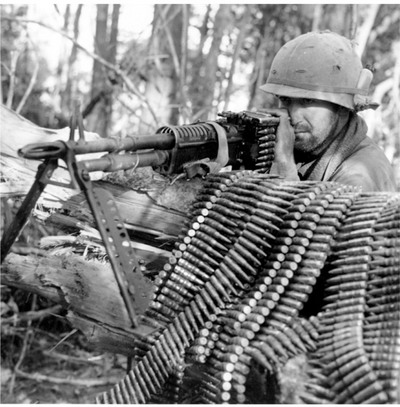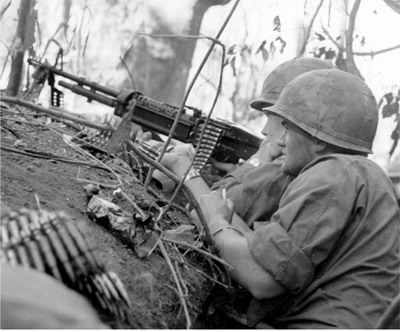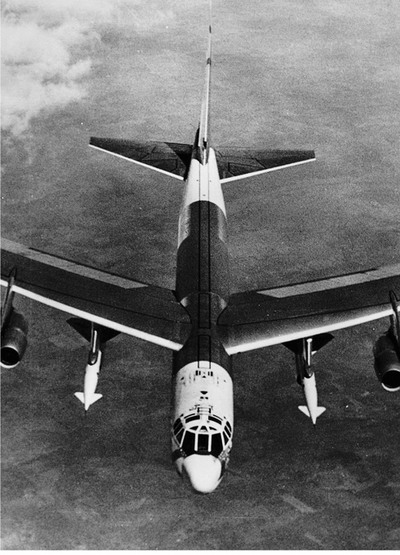Vietnam (12 page)
Authors: Nigel Cawthorne

The Jasons figured that a sixty-mile long fence could be built within a year. It would be protected by 'gravel mines', three-inches square, that would explode when they were stepped on or run over by a truck. Smaller 'button mines' the size of an aspirin would blow off a finger or a toe. Any explosion would be picked up by acoustic sensors, which would be monitored by patrol aircraft flying overhead who would drop cluster bombs, containing baseball-sized bomblets. The Jasons reckoned that 240 million gravel mines, 300 million button mines, and 120,000 cluster bombs a year would be needed. The cost: $1 billion.
Unfortunately, no mines could be found that could tell the difference between a human being and a wild animal: Vietnam engagement reports are full of incidents where air strikes were called down on some hapless water-buffalo. But the boffins were not discouraged. They experimented with bed bugs which were known to be inactive until a human body came into the vicinity and they began to move excitedly at the prospect of a meal. Electrodes that would detect movement were to be glued to the backs of bed bugs. It is said that these wired-up bed bugs were actually spread over the DMZ, but either the bugs did not take to the jungle or the glue melted.
The Jasons also came up with the idea for a pigeon-borne bomb that would explode when it landed on an enemy truck, though no-one had figured out how to train a pigeon to tell the difference between a Communist and a non-Communist truck. Then there was the sensor disguised as a pile of dog excrement, known as Turdsid. But this was quickly dropped after an Air Cav commander pointed out that, while a bear might shit in the woods, there was no evidence of dogs doing so in the jungles of Southeast Asia. Even Q, of James Bond fame, would have balked and the idea was quickly dropped.
However, some ideas did work. The 'Daisy Cutter', a massive bomb that cut a huge swathe of destruction across a wide area and recently used in Afghanistan, was developed in Vietnam. Some of the acoustic monitors worked too. In 1970, a recording from one device was played for a Congressional Sub-Committee. Representatives heard a conversation in Vietnamese, followed by the sound of axes chopping down the tree on which the device had been snagged. Then there was a crash, followed by screams as the tree fell on the men below. But the McNamara Line as a whole did not work. It proved impossible to construct it properly under the mortar and artillery barrages of the NVA, and increased activity in the DMZ meant that Communist supply lines simply reverted to the Ho Chi Minh trail which ran through Laos, around the end of the McNamara Line. In 1968, when the Marine base at Khe Sanh just south of the McNamara Line came under siege, the idea was finally discredited.
At Dak To in the Central Highlands, as at Con Thien, the fighting took on many of the characteristics of World War I. Battle raged over the muddy ridge of Hill 875 near the Lao-Cambodian border. On 19 November 1967, the 2nd Battalion of the 503rd Infantry of the 173rd Airborne Brigade headed up the western slope to annihilation. Of their sixteen officers, eight were killed. The other eight were wounded. And of the battalion's thirteen medics, eleven were killed. The wounded huddled under a tree that had been blasted to the ground for more than fifty hours. Bloody ponchos kept the night chill off. Ten helicopters that attempted to medevac them out were disabled by enemy fire. Some drew comfort that at least an effort was being made to get them out. Others died when a 500-pound bomb intended for an NVA bunker hit their position. Forty-two died in that incident. More of the wounded perished from shock, dehydration, or just plain giving up.

A machine gunner of 173rd Airborne 2nd Bn 503rd Inf with an M60, in readiness for the final assault on Hill 875, November 1967.
When the 4th Battalion turned up to relieve them, they found a moonscape scattered with dead bodies. The following morning, the NVA began pounding them with 82mm mortars, often hitting men who had already been wounded. All the grunts could do was scuttle for cover when they heard the plop of a mortar dropping down the tube and dig their foxholes a bit deeper. But as the day wore on, foxhole after foxhole got hit. A platoon under First Lieutenant Bryan MacDonough from Fort Lee, Virginia, started with twenty-seven men on Sunday and was down to nine by midday on Tuesday. The NVA kept on coming, whatever casualties they took. Seven-hundred-and-fifty-pound bombs and napalm did nothing to deter them.
By the afternoon of 22 November, a new LZ had been blasted in the hillside further down the slope. NVA mortars tried to hit it but, by the evening, 140 wounded had been medevaced out. At dusk, flamethrowers were brought in and they began to clear the enemy bunkers. By morning the 4th Battalion had made it to the ridgeline only to be thrown back that afternoon. They finally secured Hill 875 the following day, Thanksgiving, while the NVA fell back into Cambodia.
Although things were hotting up on the battlefield throughout 1967, efforts were still being made to make peace. In January, North Vietnamese Prime Minister Pham Van Dong led to international speculation that the Communists might be softening their position, though seven days later Ho Chi Minh said that Hanoi's former four-point plan for peace could now be reduced to one point: the United States should quit Vietnam. Nevertheless, the British put forward a fresh plan for a peace conference. This was rejected by Hanoi. Fresh international controversy was caused when UN Secretary General U Thant poured scorn on the idea that South Vietnam was vital to western security. However, in his State of the Union address, President Johnson promised that the US would 'stand firm in Vietnam' even though America would face 'more cost, more loss, and more agony'. On a goodwill tour of New Zealand, Premier Ky was described as a 'murderer' and a 'miserable little butcher' by the leader of the Labor opposition, Arthur Caldwell. Meanwhile in the US, Senator William Fulbright published the influential book
The Arrogance of Power
, criticising American foreign policy and advocating face-to-face talks between the US and the Vietcong. Letters were exchanged between Johnson and Ho Chi Minh, but Johnson dismissed peace feelers from Hanoi, saying that there were no 'serious indications that the other side is ready to stop the war'. Soon after, North Vietnam rejected Secretary of State Dean Rusk's suggestion that they scale down their military activities in return for a halt in the bombing campaign. In February, Congress passed a bill authorising the expenditure of another $4.5 billion on the war and $700 million in aid was given to South Vietnam, though on 12 November, 1967,
The New York Times
reported that due to corruption and blackmarketeering in Saigon 40 per cent of US aid failed to reach its destination. Senator Fulbright, chairman of the influential Senate Foreign Relations Committee, attacked Johnson's broad interpretation of the Gulf of Tonkin Resolution, saying that Johnson had no mandate to wage war on the present scale. Meanwhile the US revealed that Moscow and Peking had reached an agreement to supply North Vietnam. However, China denounced the Soviet leaders as 'a pack of traitors' and 'number one accomplices to the US gangsters'. The Chinese had fallen out with the Soviets in 1963 and in 1967 were in the middle of their 'Cultural Revolution'. They repeatedly accused the USSR of colluding with the US and 'resorting to dirty tricks with the aim of compelling the Vietnamese people to lay down their arms and give up the struggle'. Dean Rusk invoked the spectre of the 'yellow peril', but it was the Soviets rather than the Chinese who continued to support the North Vietnamese, pouring hundreds of millions of roubles' worth of food, weapons, and economic aid into the country.
With peace no nearer, U Thant told the United Nations in New York that they were witnessing the 'initial phases of World War III' and warned that direct confrontation between the US and China was likely. Johnson continued to urge Ho Chi Minh to help lead 'our people out of this bloody impasse' with a compromised peace. In June, two days of talks were held between President Johnson and Soviet Prime Minister Aleksei Kosygin in Glassboro, New Jersey. Johnson was a wheeler-dealer Texan politician, an acknowledged master of the backroom deal. In foreign affairs though, he was completely out of his depth and simply could not understand the Communists' intransigence. Despite the massive firepower ranged against them – on the battlefield Communist firepower was inferior by a ratio of about five to one – Hanoi was becoming increasingly confident. In the summer of 1967, General Giap published a book entitled
Big Victory, Great Task
in which he gallingly analysed the shortcomings of the US in combat. Again no one in the Pentagon took it to heart.
There were political changes in South Vietnam that summer. A democratically elected government was to replace the Ky military dictatorship. In May, Ky had announced that he would run for President, but in June the South Vietnamese Armed Forces Council persuaded him to be the running mate to General Nguyen Van Thieu, who had less of a gangster image and had been trained in the US. Thieu boasted about free speech and freedom of the press during the election campaign while cheerfully closing down opposition newspapers. Amid accusations of ballot-rigging, Thieu and Ky were elected. As they were sworn in at the Independence Palace in Saigon, three mortar shells exploded on the lawn.

Members of 173rd Airborne Brigade 4th Bn 503 Inf prepare for the assault on Hill 875, November 1967.

A B-52 bomber over Vietnam, 1972. The B-52 is capable of speeds in excess of 650 mph, and can reach altitudes of over 50,000 ft. It has an armaments payload of around 30,000 kilogrammes.
THE WAR IN THE AIR
THE AIR WAR BEGAN
on 8 August 1964, when President Johnson used the Gulf of Tonkin incident as an excuse to order retaliatory air strikes against coastal targets in North Vietnam. After Americans were killed at Camp Holloway, the bombing campaign Operation Rolling Thunder began in earnest when a hundred bombers from the airbase in Da Nang hit military targets in the north on 2 March with bombs cheerfully daubed with the slogan 'Ho Chi Minh ain't gonna win'. At first they used high explosives, then cluster bombs, then, on 9 March the use of napalm against targets in North Vietnam was authorised.
Although death came just as surely with high explosives, the lacerating shards of cluster bombs, bullets, mortar, or fragmentation grenades – and the Vietnam War came up with many unpleasant ways to die – it was the pictures of billowing red clouds of burning napalm and victims with their burnt skin hanging off in tatters that have become the enduring images of the war. Napalm is gasoline thickened by various additives. Although it was developed in World War II for use in flame-throwers, during the Vietnam War Dow Chemicals manufactured a version that was thickened into a gel. When a canister was dropped by a plane, it exploded near the ground, covering the target with a sticky petroleum jelly that burnt at 1,800 degrees Fahrenheit.
Gasoline had first been used as a weapon in flame-throwers in World War I, but jets of raw gasoline are difficult to aim and the gasoline burns off too quickly to set fire to the target. During World War II, scientists at Harvard found that by adding aluminium naphthenate and aluminium palmitate the gasoline was turned into a sticky syrup, which burned slowly. The additive was known as napalm, from naphthenate and palmitate. Only later did the thickened mixture adopt the name.
